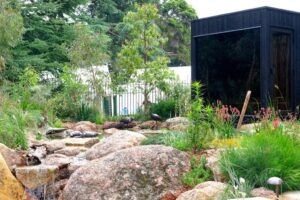
A photographic tour of MIFGS
By Gabrielle Stannus
Continuing from the article I wrote in May, which covered the Gold medal winning ‘‘ǝ’skāp’ display garden at the Melbourne International Flower and Garden Show (MIFGS), I have put together some of my other plant highlights from that event just for you! Join me on a personal photographic tour through the gardens and plants that made the Show bloom.
SHOW GARDENS
Between Moments
Ben Hutchinson Landscapes received a Silver medal for this delightful garden featuring many plants, a sauna and recreational pond, the latter probably one of those names given to a hardscape feature to make it easier to get through planning approvals! Ben is a natural pond specialist inspired by the Australian landscape as you can see in his planting selection. His connection with wildlife is seen here in the sympathetic sculptures of platypus and spoonbills inhabiting the pond.
Ben’s design philosophy is very close to my heart. His goal is to maximise the use of rainwater throughout his gardens, to use regionally and sustainably sourced materials wherever possible, and promote the use of indigenous and Australian native plants. Some of the plant highlights here include Bracteantha Whites (Xerochrysum bracteatum), mountain correa (Correa lawrenceana ‘Croajingolong’), spindly grevillea (Grevillea endlicheriana), Grevillea ‘Flame’, Grevillea ‘Murray Valley’, lemon-scented tea tree (Leptospermum petersonii), candle heath (Richea continentis), dragon heath or pineapple candleheath (Richea dracophylla), and Xerochrysum ‘Swamp’. These plants were supplied by Kuranga Native Nursery.
Richea dracophylla is endemic to Tasmania, where it is found in cool, moist environments, often in wet forests and subalpine areas. This striking foliage plant can grow up to 3m and is suited to a cool, moist garden or pot. Its creamy white flowers on terminal spikes in summer are stunning too.
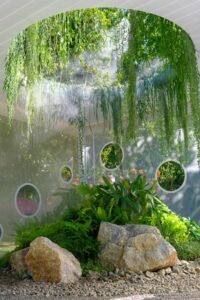
BOUTIQUE GARDENS
Managed by Landscaping Victoria, this garden display category allows established and emerging landscape designers and architects to participate in the Show. One display here really caught my eye.
Room to Breathe
Designed by Riley Field and Marie-Claire Geach from Lone Pine Landscapes, Room to Breathe received a Silver medal in the Boutique Gardens category. For me though, it was a definite show garden winner. Whilst I am all for displays sharing designs that the average punter can achieve in their backyard (or front yard), I do like designers to push the boundaries and provide a little inspiration above and beyond what we usually see. That is what a show should be about.
Room to Breathe is a beautiful garden. I describe it as a lovely (post-modern?) take on a Japanese Zen garden that would fit neatly into many a city courtyard. Plants for this garden were supplied by Fytogreen (the green infrastructure specialists with whom I completed an internship just before I finished my Master of Urban Horticulture at the University of Melbourne in 2017). Mistletoe cacti (Rhipsalis spp.) drape from the roof, whilst a flurry of ferns and other lush foliage plants reach up from the rocks. If you look closely, you will see that the plants are regularly misted to keep up the humidity.
CHALLENGER ACHIEVABLE GARDENS
This competition offers students and educational institutions the opportunity to showcase their design skills and horticultural knowledge, promote achievable gardening and encourage the use of high-quality plants in the landscape. Each year, the displays designed and constructed by these students just gets better and better, and their use of plantlife more nuanced. Here are some of my favourites from this year.
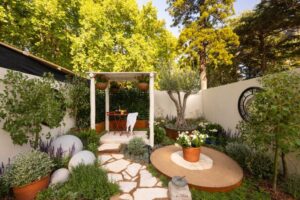
Mediterranean Musings
Adam Clements recently completed a Diploma of Landscape Design at Holmesglen TAFE, having previously gained a Diploma of Horticulture. His decision to study plants first, before design, most likely was the influencing factor in his receiving the Best Use of Plantlife award in this category, as well as a Silver medal, for his garden ‘Mediterranean musings’. The pollarded olive tree (Olea europa) from Surf Coast Palms was a real showstopper as a feature tree in this setting. An espaliered lemon (Citrus x limon ‘Eureka’) from Merrywood Plants shows Adam’s skill at finding the right plant for the right place, particularly when space is limited.
The plantlife includes a mix of textures, leaf shapes, sizes, and forms, adding depths and interest. Topiarised tree germander (Teucrium fruticans) and white correa (Correa alba) mirror the concrete spheres, showing that softscape and hardscape can complement and enhance each other in a well-designed landscape. The plants used here are all suited to a dry climate, as one would expect of a Mediterranean-inspired garden, with soft-grey foliage seen on many of the varieties.
Warners Nurseries provided many of the plants including eulalia grass (Miscanthus sinensis ‘Adagio’), blue chalksticks (Senecio serpens), woodland sage (Salvia nemorosa ‘Cardonna’) and agapanthus (Agapanthus praecox ‘Perpetual Peace’). Remarkable Trees supplied the kurrajongs (Brachychiton populneus); Humphris Nursery provided the coastal rosemary (Westringia fruticosa), and Adam sourced the red-flowered dipladenia (Mandevilla sanderi ‘Summerstar’) from Mount Evelyn Garden Centre.
The selection of agapanthus in this garden is interesting and suited to this urban courtyard setting. The African lily (Agapanthus praecox) is tolerant of a wide range of conditions and can invade forest edges and open forests across the country. The cultivar used here, Agapanthus praecox ‘Perpetual Peace’, is said to be sterile. However, if you are thinking of using it, I would suggest that you remain cautious and avoid planting it in or near environmentally sensitive areas. Best practice is to also deadhead spent flowers before seed sets.
Adam now has his own landscape design business, Tall Poppy Landscapes.
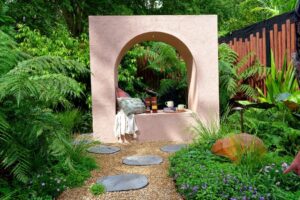
States of Green
Designed by Emily Rubia and Zoe-Beth Rush from the London College of Garden Design, ‘States of Green’ was the overall winner in the Achievable Gardens category, taking out the Excellence award and a Gold medal.
Emily and Zoe-Beth brought together a wonderful mix of plants from their respective home states, Victoria and Queensland, courtesy of Specialty Trees and Kuranga Native Nursery. Giant spear lily (Doryanthes palmeri) provides structure and height along the garden boundary, whilst various ferns provide foliage interest including alpine water fern (Blechnum penna-marina) and sickle fern (Pellaea falcata) with its pinkish hues. Tree ferns (Dicksonia antarctica) from Silvan Organics take pride of place. Perhaps living where we do in Liffey, I take having these ferns in our ‘garden’ for granted, forgetting the wonder they provide to those people who don’t live in such a setting. On another note, I loved the little purple pops of colour that the native fan flower (Scaevola aemula ‘Fairy Blue’) brought through the mostly green foliage; purple and green being the colours of the suffragettes. I have a dream one day to create what I call a garden honouring those women who fought for our rights, featuring plants with purple and green flowers and foliage.
‘As an achievable garden, we wanted it to be a space that you can enjoy all year round, with not much maintenance required necessarily with dead heading little flowers,’ said Emily, ‘If you sit in the arch. It is like a window between two worlds. Hence, why there are more of the alocasias in the background to give that Brisbane-esque, Queensland feel, and then lomandras to represent Victoria.’ A water feature provides humidity to these plants. ‘The byproduct of the water is not just the visual aspect but also the sound of running water,’ says Zoe-Beth.
Emily now runs her own landscape design business in Melbourne (Rubira By Design), whilst Zoe-Beth operates Hive Landscape Design in Queensland.
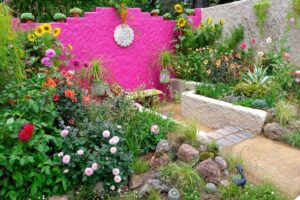
Mi Casa Es Tu Casa
The next garden provided me an opportunity to look past my own personal bias towards what I perceive to be purely ornamental plants. If I said I did not like dahlias, would you hold that against me? Mia Zielinski changed my mind about these tuberous perennials when I spoke to her about her Silver-medal-winning display. The Melbourne Polytechnic student told me that this flower is the national emblem of Mexico, and that it is both ornamental and edible. What is not to like about that?! The tuber of this plant was a food source for both the Aztecs and Mayans, the stem for water-carrying vessels, and the flower was used in their ceremonies.
‘Some of my dahlias were grown specifically for this show by The Olde Creamery,’ Mia told me, ‘They are a new dahlia farm out past Echuca. The other dahlias I bought very small, and I have just been growing them on for months. Drought Tolerant Plants provided me with the Eryngium yuccifolium (rattlesnake master), and the sunflowers (Helianthus annuus) came from Girasole Yarra Valley. Most other plants I have grown from seed, including the erigeron and grasses.’
Mia says that every plant within this garden is native to Mexico and is available in Australia too as we have many similarities in climates. Some of these plants are already old favourites in our country. Think sunflowers, Mexican asters (Cosmos bipinnatus), century plants (Agave spp.), stonecrops (in this design, Sedum mexicanum ‘Gold Mound’), ponytail palms (Beaucarnea recurvata) or the magnificent old lady cactus (Mamillaria hahnaria).
Mia said that one of her hardest challenges as a creator and a designer is editing, that is, knowing when to let something go and leave it out. She initially wanted a Mexican tree and pondered the inclusion of an avocado. In the end, Mia decided that she did not have to put a tree in, and that was that! The result is stunning and still includes structural diversity without a tree.
According to Mia, the great burnet (Sanguisorba officinalis) from Antique Perennials was a crowd favourite in her garden, and she received plenty of questions about it.
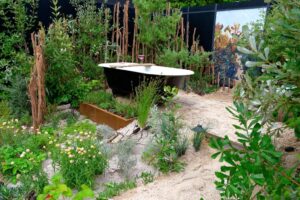
Bush Bathing
I must admit it was the bath that Katie Fraser from Melbourne Polytechnic featured in her garden ‘Bush Bathing’ that initially attracted me (along with the wineglass!). However, once I looked more closely, I was impressed by her sympathetic planting scheme. Katie also received a Silver medal for her garden, which she told me is an Australian take on the Japanese practice of ‘Shinrin-yoku’ or ‘forest bathing’.
‘The Australian equivalent is bush bathing,’ says Katie, ‘I thought I would turn that into a literal concept by using a bath as a very central motif of my garden. I want to encourage people to get out into the bush to create native and endemic landscapes within their own garden, even if it is in the suburbs, and to take time to just chill out and have a bath in the garden where you can’t bring your phone. You have nothing to do except lie in the bath and listen to the birds and feel the wind on your cheek.’
All the plants featured in this garden are locally native, and most of them are edible. Edible plants in this planting scheme include seaberry saltbush Rhagodia candolleana (berries and leaves); berry saltbush Einadia hastata (berries); bower spinach Tetragonia implexicoma (leaves once cooked); Austral stork’s-bill Pelargonium australe (tubers); and coastal saltbush Atriplex cinerea (seed, leaves). The plant selection was complemented by a botanical painting by artist Sarah Fordyce, inspired by the landscape that informed the garden’s design. Who said all the plants in a garden must be real?!
Katie says it was a challenge to find some of these plants as they are not commonly grown in commercial nurseries. ‘I bought many of these when I found out that I got into the competition, which was back in November. I went straight to an indigenous nursery in Port Melbourne called Bili and purchased about 150 plants in tubes and potted them up and have been growing them ever since. Banksia integrifolia, the coastal banksia, is increasingly available at nurseries; these were provided by Specialty Trees, and they are just fantastic specimens. I have been really delighted that they are just coming into bloom.
‘One of the hardest plants to source was the Leptospermum laevigatum, the coastal tea tree. I was very lucky to meet horticulture and design legend, Fiona Brockhoff. She uses all these plants in her designs. And I just asked her, where do you source your plants because I cannot find Leptospermum laevigatum. She put me in touch with Portsea Winery who have a small nursery, a side business, and they had some extraordinary examples of this tea tree.’
Kate also had some wise words to say about design and plant supply that I think will wrap up this section nicely. She was not afraid to source plants and advice from far and wide and had a diverse range of suppliers for this garden including Specialty Trees, Warners Nurseries, Ecodynamics Nursery, Otway Tea Tree, Newport Lakes Native Nursery, Gardening with Angus, and Yarra Edge Nursery.
‘There is no need to be purist in your plant selection. You can also put in plants that are not indigenous that you love – so long as they have similar cultural requirements, go for it!’ says Katie, adding however, that if we want to encourage people to use indigenous plants then they need to more available in nurseries. The old supply and demand issue! If you build (grow) it, will they come (buy) it?
Gabrielle Stannus
Inwardout Studio
M: 0400 431 277
E: gabrielle@inwardoutstudio.com
